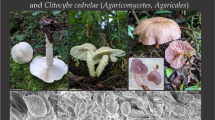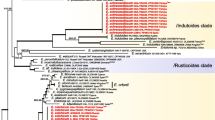Abstract
Species of macrocyclic, heteroecious grass rusts often have been defined with wide host ranges and variation in spore morphology. Consequently, some are species complexes and contain genetically distinct forms. Molecular analyses, together with morphological and biological methods, provide powerful means to dissect these complexes. Puccinia coronata is a complex species that has a broad telial host range including more than 45 genera of grasses and a narrow aecial host range. Phylogenetic analysis of nuclear ribosomal internal transcribed spacer (ITS) DNA sequences from 15 aecial and telial collections grouped P. coronata into six distinct clades supporting separation of this complex into four distinct species. Puccinia andropogonis, a common rust of tall prairie grasses in North America, is also a complex species. However, in contrast to P. coronata, P. andropogonis has a narrow telial host range and a broad aecial host range. DNA sequence analysis grouped 15 collections of P. andropogonis into six distinct clades representing at least four distinct species. Speciation of P. coronata appears to have occurred primarily by radiation onto new telial hosts, whereas in P. andropogonis speciation appears to have occurred primarily by radiation onto new aecial hosts.
Similar content being viewed by others
References
Y Anikster T Eilam J Mainsterski KJ Leonard (2003) ArticleTitleSelf-fertility and other distinguishing characteristics of a new morphotype of Puccinia coronata pathogenic on smooth brome grass Mycologia 95 87–97
Y Anikster LJ Szabo T Eilam J Manisterski ST Koike WR Bushnell (2004) ArticleTitleMorphology, life cycle biology, and DNA sequence analysis of rust fungi on garlic and chives from California Phytopathology 94 569–577 Occurrence Handle1:CAS:528:DC%2BD2cXltFynuro%3D Occurrence Handle18943481
JC Arthur (1900) ArticleTitleCultures of Uredineae in 1899 Bot Gaz 29 268–276 Occurrence Handle10.1086/327979
JC Arthur (1904) ArticleTitleCultures of Uredineae in 1903 J Mycol 10 8–21
JC Arthur (1906) ArticleTitleCultures of Uredineae in 1905 J Mycol 12 11–27
JC Arthur (1907) ArticleTitleCultures of Uredineae in 1906 J Mycol 13 189–205
JC Arthur (1934) Manual of the rusts in United States and Canada Hafner New York
BR Baum DBO Savile (1985) ArticleTitleRusts (Uredinales) of Triticeae: evolution and extent of coevolution, a cladistic analysis Bot J Linn Soc 91 367–394
MR Brown (1937) ArticleTitleA study of crown rust, Puccinia coronata Corda, in Great Britain. I. Physiological specialization in the uredospore stage Ann Appl Biol 24 504–527
GB Cummins (1953) ArticleTitleThe species of Puccinia parasitic on the Andropogoneae Uredinieana 4 5–89
GB Cummins (1971) The rust fungi of cereals, grasses and bamboos Springer-Verlag New York
JJ Davis (1929) ArticleTitleNotes on parasitic fungi in Wisconsin. XV Trans Wis Acad Sci 24 267–277
NJ Delgado CR Grau MD Casler (2001) ArticleTitleHost range and alternate host of a Puccinia coronata population from smooth brome grass Plant Dis 85 513–516
J Eriksson E Henning (1894) ArticleTitleDie Hauptresultate einer neuen Untersuchung über die Geteideroste. IV Z Pflanzenkrankh 4 257–262
J Eriksson (1908) ArticleTitleNeue Studien über die Spezielisierung der grasbewohnenden Kronenrostarten Ark Bot 8 1–26
N Eshed A Dinoor (1981) ArticleTitleGenetics of pathogenicity in Puccinia coronata: the host range among grasses Phytopathology 71 156–163 Occurrence Handle10.1094/Phyto-71-156
WP Fraser GA Ledingham (1933) ArticleTitleStudies of the crown rust, Puccinia coronata Corda Sci Agric 13 313–323
M Gardes TD Bruns (1993) ArticleTitleITS primers with enhanced specificity for basidiomycetes: application to the identification of mycorrhizae and rusts Mol Ecol 2 113–118 Occurrence Handle8180733 Occurrence Handle1:CAS:528:DyaK3sXlslOmsro%3D
Y Jin BJ Steffenson (1999) ArticleTitle Puccinia coronata var. hordei var. nov.: morphology and pathogenicity Mycologia 91 877–884
BR Kroop S Albee KM Flint P Zambino LJ Szabo SV Thompson (1995) ArticleTitleEarly detection of systemic rust infections of Dyers Woad (Isatis tinctori L.) using polymerase chain reaction Weed Sci 43 467–472
EB Mains (1933) ArticleTitleStudies concerning heteroecious rusts Mycologia 25 397–417
B Peturson (1954) ArticleTitleThe relative prevalence of specialized forms of Puccinia graminis that occur on Rhamnus cathartica in Canada Can J Bot 32 40–47
M Pfunder S Schurch BA Roy (2001) ArticleTitleSequence variation and geographical distribution of pseudoflower-forming rust fungi (Uromyces pisi s. lat.) on Euphorbia cyparissias Mycol Res 105 57–66 Occurrence Handle10.1017/S0953756200003208 Occurrence Handle1:CAS:528:DC%2BD3MXjvVyhsbo%3D
EA Schwinghamer (1955) ArticleTitleA form of crown rust occurring on Agropyron spp. in North Dakota Plant Dis Rep 39 322–324
Swofford DL (2001) PAUP*: phylogenetic analysis using parsimony (*and other methods). Sinauer Associates, Sunderland, MA
JD Thompson DG Higgins TJ Gibson (1994) ArticleTitleCLUSTAL W: improving the sensitivity of progressive multiple sequence alignment through sequence weighting, position specific gap penalties and weight matrix choice Nucleic Acids Res 22 4673–4680 Occurrence Handle7984417 Occurrence Handle1:CAS:528:DyaK2MXitlSgu74%3D
Z Urban J Marková (1994) ArticleTitleThe rust fungi of grasses in Europe. 1. Puccinia coronata Corda Acta Univ Carol Biol 37 93–147
DR Vogler TD Bruns (1998) ArticleTitlePhylogenetic relationships among the pine stem rust fungi (Cronartiun and Peridermium spp Mycologia 90 244–257
RWS Weber J Webster G Engel (2003) ArticleTitlePhylogenetic analysis of Puccinia distincta and P. lagenophorae, two closely related rust fungi causing epidemics on Asteraceae in Europe Mycol Res 107 15–24 Occurrence Handle12735240 Occurrence Handle10.1017/S0953756202006937 Occurrence Handle1:CAS:528:DC%2BD3sXit1Snsrs%3D
PJ Zambino LJ Szabo (1993) ArticleTitlePhylogenetic relationships of selected cereal and grass rusts based on rDNA sequence analysis Mycologia 85 401–414 Occurrence Handle1:CAS:528:DyaK3sXmsVGhurg%3D
Author information
Authors and Affiliations
Corresponding author
About this article
Cite this article
Szabo, L. Deciphering species complexes: Puccinia andropogonis and Puccinia coronata, examples of differing modes of speciation. Mycoscience 47, 130–136 (2006). https://doi.org/10.1007/s10267-006-0287-7
Received:
Accepted:
Issue Date:
DOI: https://doi.org/10.1007/s10267-006-0287-7




